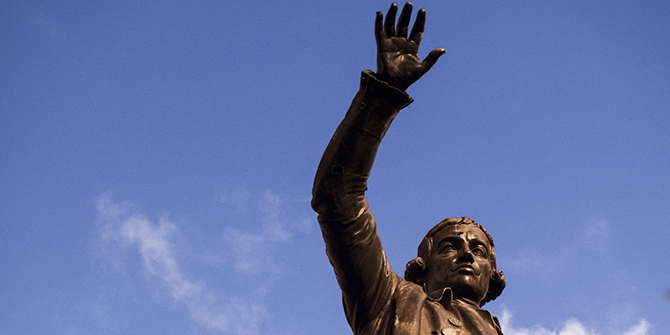 Pippa Catterall discusses the role of monuments in public spaces and argues that they represent what people in the past chose to celebrate and memorialise. Consequently, they do not represent history but mediate a conversation between past and present.
Pippa Catterall discusses the role of monuments in public spaces and argues that they represent what people in the past chose to celebrate and memorialise. Consequently, they do not represent history but mediate a conversation between past and present.
Britain’s public spaces throng with statuary and monuments. Mostly erected during Victorian times, these represent what the elites who controlled these spaces then considered important as statements about themselves and their society. This residue of past decisions continues to shape our public realm.
Since the toppling of that of the slave-trader Edward Colston in Bristol on 7 June, these statues have suddenly become much more noticed than usual. Colston’s statue’s fate has prompted much hand-wringing about statues being necessary to teach history, admittedly mostly from people who had probably never heard of either Colston or his unsavoury history before. Most of the time, statues are to most of the public simply white noise in stone or bronze, passed unseen in the square or street. It was not history that was in play with Colston’s statue, but what people chose to interpret his statue as representing about the values and nature of Britain’s society today, and its relationship with its violent imperial past. Heritage, in other words, is always mediating a conversation between the Past – not least the reasons why it was erected in the first place – and the Present dealing with its sometimes problematic legacies.
This issue is not new. As long ago as 1868, the statue of ‘Bloody’ Cumberland was removed from Cavendish Square in London and melted down. Neither his sanguinary associations nor his artistic representation were felt to be worthy of commemoration or retention. The British have also replaced other people’s statues in the process of replacing one empire with another. That of Hermann von Wissmann, for instance, was removed from Dar es Salaam after the British conquered German East Africa during the First World War. They sent it to the University of Hamburg. As Wissmann’s reputation shifted from imperial hero to racist villain, the statue was first attacked and then removed in 1967-68. It has taken Bristol 52 years to catch up with its German counterpart. Now, however, both statues have become monuments to anti-imperial and anti-racist protests. The dialogue between Past and Present they represent has dramatically altered.
Because of their role in this dialogue, statues cannot be treated as sacrosanct. They represent what people in the Past chose to celebrate and memorialise, they do not represent history. Indeed, teaching history is almost never the reason why they are erected. Instead, statues in public spaces since Antiquity have most typically been used to represent power and authority. It is therefore no coincidence that so many of the Confederate monuments that have proved so controversial in America in recent years were erected less to commemorate the US Civil War than to express the power relations of the Jim Crow era decades later. This also reflects another perennial facet of statues throughout history: they have mostly been of men, usually from the military. The database of the Public Monuments and Sculpture Association suggests that only 2.7 per cent of the civic statues in Britain are of non-royal women. Statues carry the Matilda Effect of overlooking the achievements of women into a public realm from which the Victorians who created much of Britain’s public spaces saw them as excluded. Instead, the domestic sphere was designated female. Female representation in Victorian statuary, if it exists at all, is usually anonymous and titillatingly semi-clad or naked.
Other groups in British society are even more occluded. The various memorials to Alan Turing are among the few to a non-straight individual. Yet neither his place in the history of sexuality nor that of Mary Seacole, the subject of the adjacent statue on St Mary’s Terrace in West London, in Black history is conveyed either by the representation or interpretation. Turing is commemorated for what he did for the British state, but even in the interpretation at the statue of him in the gay quarter of Manchester there is no representation of what the British state did to him and hundreds of other gay men. Nor was there any representation of the estimated 19,000 slaves for whose deaths Colston’s company was responsible in Bristol. The nearest Britain has got to confronting that uncomfortable past in a memorial is in the representation of the slaves thrown overboard in the recent installation of Fons Americanus in the Tate Modern. Even then it took an outsider, the African-American artist Kara Walker, to raise the issue. This was a temporary batsqueak of protest against the chorus of imperial statues. Accordingly, if statues implausibly convey British history, then it is clearly one that is both heavily skewed and exclusive.
Long after Fons Americanus has been dismantled the celebration of British imperialism it critiques – the Victoria Memorial outside Buckingham Palace – will still be standing, whitewashing that imperial past. It is time, therefore, to recognise that such public monuments are not neutral. They are created for particular ends and convey particular, often problematic, narratives. All too often, they do not so much teach history as bowdlerise the Past. For instance, there may be a monument to the animals who died in two world wars, but the suggestion in 1916 that a mosque should be built in London to commemorate the thousands of Muslims who were then fighting and dying for Britain was roundly dismissed. No wonder only 22 per cent of the public appreciate that Muslims fought for Britain in those conflicts.
Monuments, by their emphases and absences, distort history as much as they inform it. The narratives they intrude into the Present about power structures, values, and (too often) violence need to be challenged. This doesn’t have to be done by removal. The ironic way in which the monument to the Red Army in the King’s Garden in Sofia has been regularly repainted by protesters to make political statements is a different, and in many ways wittier, way of engaging in the dialogue between the Past and the Present that these monuments represent. As the added caption so aptly put it when these protesters painted the monument to look like Captain America, Ronald McDonald and assorted other American icons, this way these monuments are kept ‘In Pace with the Times’.
__________________
 Pippa Catterall is Professor of History and Policy at the University of Westminster
Pippa Catterall is Professor of History and Policy at the University of Westminster
All articles posted on this blog give the views of the author(s), and not the position of LSE British Politics and Policy, nor of the London School of Economics and Political Science. Featured image credit: Photo by James Eades on Unsplash.








Interesting article, I would be grateful if you could share any sources you consulted for this.